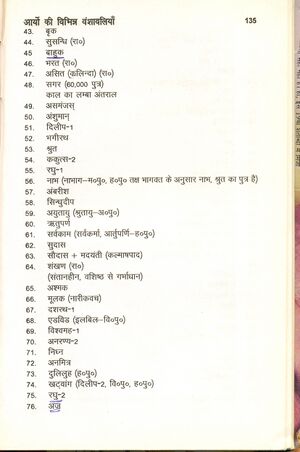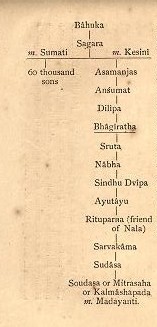Sagara

Maharaja Sagar (महाराजा सगर) is one of the greatest kings of Suryavansh in the Satya Yuga. He is ancestor to King Dasharatha and Lord Rama.[1]
Variants
History

King Sagar performed a horse sacrifice (Ashwamedha yajna) to prove his supremacy. Lord Indra, the leader of the demigods, became fearful over the results of the yajna, so he decided to steal the horse. He left the horse at the ashram of Kapila, who was in deep meditation. King Sagar’s 60,000 sons (born of Queen Sumati) and his son Asamanjas (born of Queen Keshini) were then sent to find the horse. When the 60,000 sons found the horse at Kapiladeva’s ashram, they thought he had stolen it. When they prepared to attack the meditating rishi (sage), Kapiladeva opened his eyes. Because the sons of King Sagara had disrespected such a great personality, consequently, fire emanated from their own bodies, and they were immediately burned to ashes.
Later King Sagar sent his grandson Anshuman to retrieve the horse. Kapiladeva returned the horse and told Amsuman that the sons of King Sagar could be delivered if the Ganges descended to earth and bathed them in her waters. King Sagar’s great-great-grandson, Bhagiratha, eventually pleased Mother Ganga, and asked her to come to earth. Mother Ganga told Bhagiratha that the force of the Ganges falling from heaven would be too great for the earth to sustain, and that she needed someone to break the fall. Bhagiratha then worshiped Lord Shiva, who then agreed to accept the descending river upon his head.
King Bhagiratha then preceded the holy river with his chariot and ripped open a gorge in which the Ganga (Ganges) could flow. The river followed the King to Ganga Sagar at the Bay of Bengal, where Kapiladeva resides. The Ganga River then bathed the remains of the 60,000 sons and returned them to their eternal positions.
सगराद्रि
सगराद्रि (AS, p.930): कर्नाटक में मुम्बई-रायचूर रेलमार्ग पर यादगिरि स्टेशन के निकट स्थित एक पहाड़ी, जो पुराण प्रसिद्ध राजा सगर के नाम पर प्रसिद्ध है। सगर का बनवाया हुआ एक दुर्ग यहाँ स्थित था। बीजापुर के सुल्तानों ने यहाँ क़िले का निर्माण करवाया था। सगराद्रि की तलहटी में सगर नामक एक प्राचीन नगर स्थित है, जिसे अब 'शाहपुर' कहा जाता है। [2]
जाट इतिहास
कैप्टन दलीप सिंह अहलावत[3] ने लिखा है ..... वैदिक सम्पत्ति लेखक पं० रघुनंदन शर्मा ने पृ० 424 पर लिखा है कि वैवस्वत मनु के इक्ष्वाकु, नरिष्यन्त (नरहरि) आदि 10 पुत्र हुए। इस लेखक ने विष्णु पुराण एवं हरिवंश का हवाला देकर लिखा है कि नरिष्यन्त के पुत्रों का ही नाम शक है। इनकी प्रसिद्धि से इनके नाम पर क्षत्रिय आर्यों का संघ शकवंश कहलाया जो कि एक जाटवंश है। सम्राट् सगर ने अपने पिता बाहु की हार का बदला शत्रुओं को हराकर इस तरह से लिया कि उसने शकों, पारदों, यवनों और पह्लवों को अपने देश से निकाल दिया। शक लोगों ने आर्यावर्त से बाहिर जाकर एक देश आबाद किया जो कि इनके नाम से शकावस्था कहलाया जिसका अपभ्रंश नाम सीथिया पड़ गया।
Reference
- ↑ Dr Mahendra Singh Arya, Dharmpal Singh Dudi, Kishan Singh Faujdar & Vijendra Singh Narwar: Ādhunik Jat Itihas (The modern history of Jats), Agra 1998
- ↑ Aitihasik Sthanavali by Vijayendra Kumar Mathur, p.930
- ↑ Jat History Dalip Singh Ahlawat/Chapter IV (Pages 321-322)
Notes
Back to The Ancient Jats

